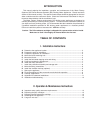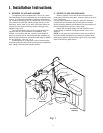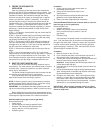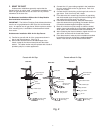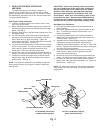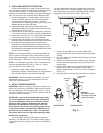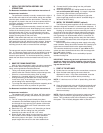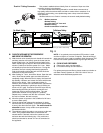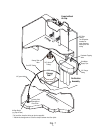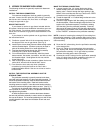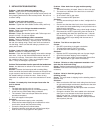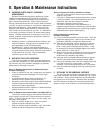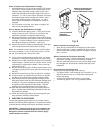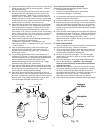
A. IMPORTANT WATER QUALITY ASSURANCE
REQUIREMENTS
Reverse Osmosis drinking water appliances contain
treatment components that are critical for the effective
reduction of Total Dissolved Solids (TDS) as well as inor-
ganic chemical contaminants. Water Factory Systems
®
strongly recommends that the user test the water periodical-
ly (every six months minimum) to verify that the appliance is
performing satisfactorily. Some models have a Percent
Rejection (PR) Water Quality Monitor to provide the user
with a means to test the water at any time. If a PR Monitor
is not used, your dealer will offer a bi-annual water testing
service. Routine maintenance is necessary in the form of
prefilter, postfilter, and membrane replacement, based on
the following guidelines:
• Sediment, Carbon, or Sediment/Carbon Prefilters, and
Carbon Postfilters: Change every six months to one
year depending on the feed water quality.
• RO Membrane: Change it as required based on a
built-in Percent Rejection (PR) Water Quality Monitor. A
bi-annual testing service will be offered by your dealer if
a (PR) Monitor is not used. The recommended
maximum service life is 36 months.
B. REPLACING THE FILTER CARTRIDGES
The life of the prefilter cartridge generally depends on
the local water conditions (i.e., dirt, rust and/or chlorine lev-
els) while the life of the postfilter cartridge(s) is generally
determined by the length of service.
When to Replace the Sediment or Sediment/Carbon
Prefilter Cartridge(s)
• Every six months to one year, based upon your dealer's
recommendation and knowledge of the local water
conditions.
• A noticeable decrease in water production is an
indication that the prefilter requires changing.
• Generally, private wells require more frequent sediment
prefilter changes while softened feed water usually
requires only yearly replacement.
• Recommended maximum sediment or sediment/carbon
prefilter service life is one year.
When to Replace the Carbon Prefilter Cartridge (SQC 4)
The carbon prefilter removes free chlorine from the feed
water supply to protect the TFCM membrane from chlorine
attack. To find out the chlorine level in a water supply, call
the public water supplier.
• With free chlorine levels up to 1 mg/L, the carbon
prefilter should be changed every year.
• With free chlorine levels exceeding 1 mg/L, the carbon
prefilter should be changed every six months.
When to Replace the Carbon Postfilter Cartridge
• If the filter is being used to control tastes and odors,
replace it every year.
• If the filter is being used to reduce chloramines, change
it every six months. For critical applications such as
aquariums, base the filter change on periodic
chloramine (combined chlorine) tests.
• If the filter is being used to meet standards for a
regulated organic chemical contaminant, then cartridge
replacement should be based on a monitoring program
established with a public health agency.
How to Replace the Prefilter and
Postfilter Cartridges
1) Lift up on the faucet handle to drain the tank. Close the
feed water tapping valve. Wait five (5) minutes for the
purification assembly to completely depressurize.
2) Twist the filter cartridge 1/4 turn clockwise so that the
ears on the cartridge are able to disengage from the
head. Firmly pull the cartridge from the head. It may
be necessary to twist the cartridge slightly from side to
side to help free it. (See Fig. 8)
3) Remove the new filter cartridge from its sanitary sealed
wrapper. (Double check to see that it is the correct
replacement by comparing the labels.)
4) Using tap water, food grade silicone lubricant or glycerin,
wet the o-ring seals to make cartridge insertion easier.
5) Line up the cartridge ears, insert the cartridge and push
it into the head until it is fully seated. Twist the
cartridge 1/4 turn counterclockwise to lock it into place.
6) Open the feed water tapping valve and carefully check
for leaks.
C. REPLACING THE RO MEMBRANE CARTRIDGE
The life of the RO membrane cartridge depends on the
local water conditions and proper maintenance, e.g., regular
filter changes. Under typical conditions, the RO membrane
life ranges from 18-36 months. Unlike the filter cartridges,
the RO membrane cartridge life is not determined by the
amount of water used because of its self-cleaning feature.
II. Operation & Maintenance Instructions
13



